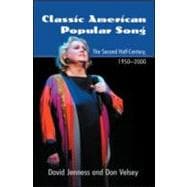
Note: Supplemental materials are not guaranteed with Rental or Used book purchases.
Purchase Benefits
Looking to rent a book? Rent Classic American Popular Song: The Second Half-Century, 1950-2000 [ISBN: 9780415970563] for the semester, quarter, and short term or search our site for other textbooks by Jenness; David. Renting a textbook can save you up to 90% from the cost of buying.
| Acknowledgments | ix | ||
| Introduction | xi | ||
| 1 Classic Pop at Midcentury | 1 | (44) | |
| 2 The Music Went Round and Round... | 45 | (22) | |
| 3 Late Flowering from Old Stock | 67 | (38) | |
| 4 Indian Summer of the Classic Popular Song | 105 | (42) | |
| 5 Restocking the Songbook | 147 | (58) | |
| 6 The Land Where the Good Songs Go | 205 | (38) | |
| 7 Other Voices in Popular Song | 243 | (38) | |
| 8 Sondheim and After | 281 | (48) | |
| 9 Classic American Popular Song at the End of the Twentieth Century | 329 | (12) | |
| Permissions | 341 | (18) | |
| General Index | 359 | (8) | |
| Song Index | 367 | (14) | |
| Songwriters' Index | 381 |
The New copy of this book will include any supplemental materials advertised. Please check the title of the book to determine if it should include any access cards, study guides, lab manuals, CDs, etc.
The Used, Rental and eBook copies of this book are not guaranteed to include any supplemental materials. Typically, only the book itself is included. This is true even if the title states it includes any access cards, study guides, lab manuals, CDs, etc.